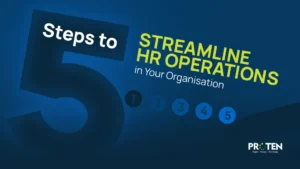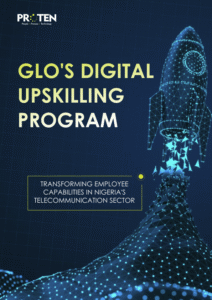Did you know that 70% of change initiatives fail because leaders fail to consider the emotional aspects of the employees, leading to withdrawal and desire to leave? While some changes may seem straightforward, like a new software system, or a department merge, the reality is that any transformation can be disruptive and lead to employee resistance. This is where change management comes in.
Change management is a structured approach to transitioning individuals and teams through organizational shifts. It’s not about simply announcing a new policy and hoping for the best. Effective change management recognizes that people are the heart of any organization, and their successful adoption of the change is critical for its overall success.
As an HR manager, you are pivotal in navigating these transitions. From clear communication and training to addressing employee concerns and building trust, your expertise in people management is essential for ensuring a smooth and successful change adoption process. This article will equip you with the knowledge and strategies to become a champion for change within your organization.
How Changes Impact People and Work
Organizational changes, big or small, can have a ripple effect throughout the company, directly impacting people and their work. Here’s how:
- New Skills and Workflows: Implementing a new software system, restructuring a department, or even adopting a new marketing strategy can require employees to learn new skills and adapt to different workflows. This can be stressful and lead to a period of decreased productivity as they adjust.
- Uncertainty and Anxiety: Change inherently brings uncertainty. Employees may worry about job security, their ability to adapt to new procedures, or how their workload might be affected. This anxiety can manifest as decreased motivation, lower morale, and increased absenteeism.
- Communication Gaps: Without clear communication about the “why” and “how” of the change, employees can be left feeling confused and frustrated. This can lead to misunderstandings, rumors, and ultimately, resistance to the change.
Your Role as the Change Management Champion
As an HR manager, you are at the forefront of ensuring a smooth transition during these times. Here’s how your expertise plays a crucial role:
- Communication is Key: You spearhead clear and consistent communication throughout the change process. This involves explaining the rationale behind the change, timelines, potential impacts, and addressing employee concerns proactively. You craft different communication channels like town halls, emails, and internal platforms to reach everyone effectively.
- Training and Development: HR identifies skill gaps and creates training programs or workshops to equip employees with the knowledge and tools needed to thrive under the new circumstances. This could involve training on new software, providing leadership development opportunities, or offering workshops on managing change effectively.
- Employee Support: Change can be stressful. HR plays a vital role in providing support to employees during the transition. This could involve setting up channels for feedback, addressing anxieties through one-on-one meetings or support groups, and promoting a culture of open communication where employees feel comfortable voicing their concerns.
The Cost of Resistance and the Power of Change Management
Employee resistance to change can be a significant hurdle to its success. This resistance can manifest as decreased productivity, increased errors, and even employee turnover. Studies have shown a direct correlation between employee resistance and the financial performance of an organization.
Effective change management acts as a powerful tool to minimize resistance. By following a structured approach that focuses on clear communication, employee training, and addressing concerns, you can build trust, ownership, and ultimately, acceptance of the change. This leads to a smoother transition, increased employee engagement, and a higher chance of achieving the desired outcomes from the change initiative.
The Principles of Change Management
So, what makes change management, change management? We’ll be discussing that in detail below. Here’s a breakdown of the core principles of change management that you can leverage as an HR manager:
People-Centric Approach:
- Focus on the “Why”: This principle emphasizes clearly communicating the rationale behind the change. Employees are more likely to embrace change if they understand the purpose and how it benefits the organization (and themselves). Frame the change as an opportunity for growth and improvement.
- Address Concerns: Acknowledge and address employee anxieties and concerns openly. People naturally resist what they don’t understand. Hold open forums, Q&A sessions, or surveys to gather feedback and proactively address common concerns.
- Empowerment: Involve employees in the change process whenever possible. This can be through soliciting feedback on new procedures, creating committees with employee representatives, or assigning ownership of specific aspects of the change to different teams. Giving employees a sense of control and ownership fosters buy-in and reduces resistance.
Communication is Paramount:
- Transparency is Key: Be transparent about the change, its timeline, and potential impacts. Avoid sugarcoating or withholding information. Employees appreciate honesty and trust leadership to be upfront about challenges.
- Consistent Messaging: Ensure consistent communication across all levels of the organization. This means leadership, HR, and managers all using the same language and messaging to avoid confusion and misinformation. Develop a communication plan that outlines key messages and designates spokespersons for different channels.
- Multiple Channels: Don’t rely on a single communication channel. Utilize various methods like town halls, emails, internal communication platforms, department meetings, and even video messages to reach all employees effectively. Consider tailoring messages to different teams or departments based on their specific needs and concerns.
Leadership and Sponsorship:
- Visible Leadership: Strong leadership commitment and active sponsorship from senior management are crucial for successful change initiatives. Leaders should embody the change, champion its benefits, and be visible throughout the process. Employees need to see leadership invested in the change for them to follow suit.
- Role Models: Identify and empower change champions within the organization. These can be employees at different levels who are enthusiastic about the change and can inspire and support colleagues during the transition. Change champions can answer questions, provide guidance, and create a positive buzz around the new way of working.
Your Role In Implementing Change
As mentioned before, you play a pivotal role as an HR manager in ensuring a smooth and successful implementation of changes within the organization. Here’s a breakdown of your key responsibilities during change initiatives:
1. Championing Change:
- Advocate and Translator: You become a strong advocate for change within the organization. This involves understanding the leadership’s vision for the change and translating it into clear and compelling messages for employees. Communicate the benefits of the change, how it aligns with the organization’s goals, and ultimately, how it will positively impact employees’ work.
- Building Buy-in: You play a crucial role in building employee buy-in for the change. This involves creating a sense of ownership and excitement around the new way of working. Develop communication strategies that address employee concerns, involve them in the process whenever possible, and celebrate successes along the way.
2. Communication Powerhouse:
- Clear and Consistent Messaging: You spearhead the development and execution of a clear and consistent communication plan throughout the change process. This involves crafting messages that explain the “why” and “how” of the change, timelines, and potential impacts. Utilize various communication channels like town halls, emails, internal platforms, and even video messages to reach all employees effectively. Ensure consistent messaging across all levels of the organization to avoid confusion.
- Addressing Concerns: Anticipate and address employee concerns proactively. This involves setting up channels for feedback, such as surveys, focus groups, or one-on-one meetings. Actively listen to employee concerns, address them transparently, and provide clear explanations.
3. Training and Development Specialist:
- Identifying Skill Gaps: Analyze the change and identify the skills and knowledge employees will need to succeed under the new circumstances. This could involve new software functionalities, updated workflows, or different leadership approaches.
- Developing Training Programs: Based on identified skill gaps, you play a key role in developing or sourcing training programs and workshops. This could involve in-house training sessions, online learning modules, or partnering with external training providers.
- Ensuring Knowledge Transfer: Facilitate the transfer of knowledge and ensure employees have the resources they need to adapt to the change. This could involve creating knowledge-sharing sessions, mentoring programs, or readily available online resources for reference.
4. Employee Support System:
- Change Can Be Stressful: Recognize that change can be stressful for employees. Provide support mechanisms to help them navigate the transition. This could involve offering stress management workshops, establishing employee support groups, or creating a culture of open communication where employees feel comfortable voicing concerns.
- Performance Management: During periods of change, performance management practices might need adjustments. Work with managers to develop clear performance expectations aligned with the new way of working. Provide guidance and support to managers for effectively coaching and evaluating employees during the transition.
By taking a proactive approach to these core responsibilities, you, as the HR manager, can significantly increase the success rate of organizational changes and ensure a smoother transition for your employees. Successful change management is about people, and your expertise in human resources is vital for navigating these transitions effectively.
In Conclusion…
As an HR manager, you wear many hats during organizational change. Change impacts people directly, and your expertise is crucial for a smooth transition. By championing the change, crafting clear communication, and providing training and support, you can build employee buy-in and minimize resistance. Your role extends to addressing concerns, ensuring knowledge transfer through training, and even adapting performance management practices during this time.
Effectively managing change is a valuable skill for any HR professional. At Proten International, we have numerous resources available to help you go deeper. Reach out to us for a specifically tailored workshop for you to gain insight from reputable institutions. Investing in your knowledge of change management practices will empower you to become an even stronger advocate for change within your organization.










